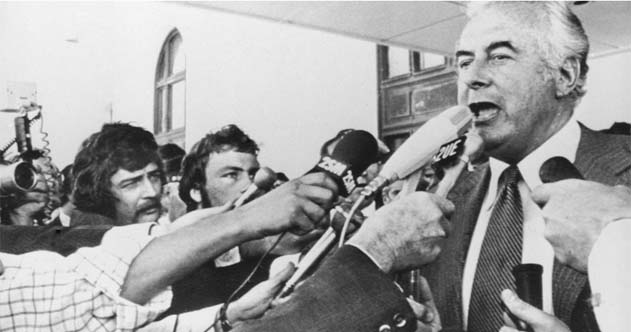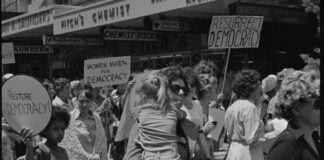Gough Whitlam is remembered as a radical reformer, but his demise laid the ground for Labor’s move to the right, writes Mark Gillespie
Gough Whitlam’s Labor government was swept to power 50 years ago on 2 December 1972, ending 23 long years of conservative government. Whitlam had an agenda of substantial progressive reform and set about implementing it immediately.
Within days conscription was abolished but much more was to follow.
Fifty years on Anthony Albanese is keen to paint his government in the same progressive reforming tradition, listing Whitlam’s policies of, “Universal healthcare. Land rights. Urban renewal. Equal pay. Better school and university funding”, and adding, “We are proud to build on that legacy in our government”.
While the election of Albanese after nine years of Coalition governments is a relief, the gap between Labor today and 50 years ago is enormous.
Whitlam not only ended conscription but abolished university and TAFE fees and doubled school funding; quadrupled funding for housing; tripled urban development expenditure; increased health spending by 20 per cent and introduced a universal national health care system. He established diplomatic relations with “Communist” China; formally ended White Australia; granted Papua New Guinea its independence; drafted the Racial Discrimination Act; handed Wattie Creek back to the striking Gurindji stockmen; introduced no-fault divorce, legal aid and much much more.
Albanese’s agenda in comparison is mild. There is more continuity with the past than change—summed up by Labor’s commitment to keep the massive stage three tax cuts for the rich.
So moderate is Labor’s agenda that some argue they have broken with their reforming social democratic traditions. Adam Bandt, for example, praises Whitlam glowingly while claiming The Greens are now the only party “offering a social democratic alternative”.
But this idolises Whitlam and misses the real weakness with the social democratic tradition that both Whitlam and Albanese share. To understand why Whitlam was so much bolder than Albanese today, we need to look at the context of his 1972 election.
Mass movements
Whitlam was elected on the back of a rising mass movement that shook Australian capitalism to its foundations. Support for the Vietnam War collapsed in 1968 and by 1970 there were massive moratorium marches against the war. Trade unions, too, were on the offensive after an almost spontaneous general strike freed the jailed tramways union official Clarrie O’Shea in 1969 and made the Liberals’ anti-union penal powers a dead letter.
The struggle for Indigenous rights was on upward curve, beginning with the famous freedom rides in 1965 that challenged segregation in outback towns in NSW; the 1966 strikes by Aboriginal pastoral workers in Northern Territory who demanded equal pay and later land rights; through to the establishment of the famous tent embassy on the lawns of Parliament House in 1972.
The Women’s Liberation Moment and the Gay Liberation Movement, too, burst onto the scene during this period. The depth of radicalisation in society is probably best measured by the involvement of trade unions in industrial action to support progressive political causes such as the anti-war moratoriums, the opposition to the 1971 South African Springbok tour, and the famous Green bans.
It was these movements that created the mood for change in society and shifted Whitlam to the left.
This is best demonstrated by his changing position on the Vietnam War. Whitlam became Labor leader following Labor’s crushing defeat in the 1966 election over the issue of Vietnam. His response was to try to “de-escalate” the issue, watering down the party’s already ambiguous opposition to the war.
In 1967, following a hysterical backlash against Monash University students who announced their intention to aid the enemy by collecting money for the Vietnamese National Liberation Front (NLF), Whitlam denounced them as a “handful of anarchists and exhibitionists” and voted with the conservatives to outlaw collections.
But by 1969 Whitlam had come to see opposition to the war as an “electoral asset” and promised: “Under Labor, there will be no troops in Vietnam after June 1970”. He also began endorsing “peaceful demonstrations” saying they “are as legitimate and as necessary a part of the democratic processes as elections”. Only a year earlier he’d been saying Labor’s foreign policy would not be determined by petitions and mass meetings.
According to right-wing Labor politician Fred Daley “Whitlam had sniffed the breeze and being pragmatic, changed his attitude on Vietnam”.
Economic boom
The other factor shaping Whitlam’s ability to bring change was the shape of the economy. Whitlam was elected at the peak of the post-war boom when capitalism could live with substantial reforms.
Whitlam’s reforms, however, were never about redistributing wealth but about modernising capitalism. Investment in health and education made sense from a capitalist point of view as business required a well-educated, healthy workforce to compete within the modern, changing and increasingly global economy.
These reforms were always predicated on the economic boom continuing, ensuring capitalism’s ability to pay without threatening profits. As Whitlam said, “Our program, particularly in education, welfare, hospitals and cities, can only work successfully within a framework of strong uninterrupted growth”.
Whitlam never wanted to challenge the madness of the market, but rather to make it work more efficiently. In 1973 he cut import tariffs by 25 per cent across all industries as part of the process of opening up the economy to global competition and forcing industry to restructure and to invest in new technology.
This explains why the Murdoch press and other leading business figures happily endorsed Whitlam in the 1972 election.
Whitlam increased government spending by 40 per cent in the 1973 budget and still had a surplus of $211 million. This stands in sharp contrast to the economic conditions Albanese faces today where the budget has not been in surplus since 2008 and government debt its highest as a share of GDP since 1950.
Whitlam’s dream run, however, ended with the 1973-75 global recession. After decades of growth and virtual full employment, unemployment climbed to about 5 per cent while inflation ballooned, reaching a staggering 22 per cent.
And just as the Albanese government uses the “trillion dollars of debt” as an excuse today not to increase the JobSeeker allowance, so too did Whitlam use the state of the economy to wind back reforms.
Many argue that Labor’s embrace of neoliberal economics and its move to the right began with the Hawke and Keating governments from 1983. But Whitlam’s response to recession was not so different. Handouts went to the corporate sector to try to get them to invest while government spending was cut, alongside an attempt to restrain wages.
“We are no longer operating in that simple Keynesian world” said Whitlam’s Treasurer, Bill Hayden in his 1975 budget speech, “today, it is inflation itself which is the central policy problem”. Hayden cut corporate taxes by 2.5 per cent while exercising “the utmost restraint on government spending” with cuts across the board.
The Whitlam government also moved to rein in the unions that were using their industrial power to fight the effects of inflation. First they appealed to unionists to “Go easy mate”, then they attacked sections of the movement for “bloody-mindedness”, and finally introduced wage indexation (where arbitration courts set the wage rates). By the end of 1975 metal industry bosses expressed their support for indexation as it “helped to dampen a dangerous pattern of wage growth”.
The Dismissal
This was the first serious recession since the end of the Second World War—and it sent the ruling class into a panic. Business felt Whitlam wasn’t acting fast or hard enough and were desperate for a government that would take savage measures against unions and the working class.
Regardless of Whitlam’s efforts to give them what they wanted, he nonetheless faced an extraordinary extra-parliamentary campaign by the corporate media, business executives and the establishment, in co-operation with the Liberal Party, to hound him out of power.
This culminated with the unelected Governor General, John Kerr, sacking the elected Prime Minister on 11 November 1975.
Whitlam’s dismissal provoked outrage, with immediate mass demonstrations and strikes. Seafarers, wharfies, rail workers, building workers, meat workers and metal workers all walked off the job in protest. There was immense pressure on Bob Hawke, then President of the ACTU, to call a general strike.
But Whitlam, forever committed to working through parliament, was not about to unleash this tiger. Instead, he urged workers to “maintain your rage” until election day, while Bob Hawke told workers to “cool it” and donate a day’s pay to Labor’s re-election campaign instead of striking.
This demobilised workers, leaving them more isolated and exposed to the mass media hammering the message that Whitlam had wrecked the economy. The predictable result was an election win for the Liberals’ Malcolm Fraser.
Whitlam’s dismissal has allowed him to go down in Labor mythology as a great social democratic reformer who stood up to the powers that be. The Labor Party responded to his sacking by concluding he had gone “too far, too fast” and vowing to never attempt anything similar again.
But it is important to see what Whitlam and the Labor leaders that followed him have in common. They all seek to manage the capitalist economy in a “fairer” way for workers. But this means accepting responsibility for guaranteeing the profits and wealth of big business and the rich.
When capitalism is sick and profits and investment are weak, it means implementing the cuts to wages and public services needed to get the system back to health. This is why so many Labor governments end up attacking their own working class supporters. Whitlam was no exception.
Rather than idealise Whitlam and the social democratic tradition we need a new set of politics—one that looks to the power of organised workers and mass movements outside of parliament. This is the power that forced Whitlam to the left and made the changes he did deliver possible in the first place.






